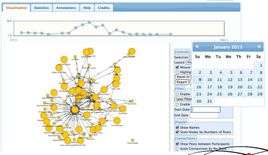The educational technology and digital learning wiki
Jump to navigation
Jump to search
|
|
| Line 8: |
Line 8: |
| |field_last_version=2.1 | | |field_last_version=2.1 |
| |field_website=http://www.snappvis.org | | |field_website=http://www.snappvis.org |
| |field_description= | | |field_description=SNAPP essentialy serves as a diagnostic instrument, allowing teaching staff to evaluate student behavorial patterns against learning learning activity design objectives and intervene as required in a timely manner. |
| |field_data_tool_type= | | |field_data_tool_type= |
| |field_plugin_of= | | |field_plugin_of= |
Revision as of 16:20, 26 February 2014
Social Networks Adapting Pedagogical Practice 2.1
Developed by: Dawson, S., Bakharia, A., & Heathcote, E.
License: Free&Open source
Web page : Tool homepage
Tool type :
The last edition of this page was on: 2014/02/26
The Completion level of this page is : Low
The last edition of this page was on: 2014/02/26 The Completion level of this page is : Low
SHORT DESCRIPTION
SNAPP essentialy serves as a diagnostic instrument, allowing teaching staff to evaluate student behavorial patterns against learning learning activity design objectives and intervene as required in a timely manner.
TOOL CHARACTERISTICS
Usability
Authors of this page consider that this tool is '.
Tool orientation
This tool is designed for general purpose analysis.
Data mining type
This tool is made for '.
Manipulation type
This tool is designed for '.
| Tool objective(s) in the field of Learning Sciences |
|
☑ Analysis & Visualisation of data
☑ Predicting student performance
☑ Student modelling
☑ Social Network Analysis (SNA)
☑ Constructing courseware
|
☑ Providing feedback for supporting instructors:
☑ Recommendations for students
☑ Grouping students:
☑ Developing concept maps:
☑ Planning/scheduling/monitoring
☑ Experimentation/observation
|
ABOUT USERS
Tool is suitable for:
Students/Learners/Consumers
Teachers/Tutors/Managers
Researchers
Developers/Designers
Organisations/Institutions/Firms
Others
FREE TEXT
Tool version : Social Networks Adapting Pedagogical Practice 2.1
(blank line)
Developed by : Dawson, S., Bakharia, A., & Heathcote, E.
(blank line)
Tool Web page : http://www.snappvis.org
(blank line)
Tool type :
(blank line)
Free&Open source
| 
|
SHORT DESCRIPTION
SNAPP essentialy serves as a diagnostic instrument, allowing teaching staff to evaluate student behavorial patterns against learning learning activity design objectives and intervene as required in a timely manner.
TOOL CHARACTERISTICS
| Tool orientation |
Data mining type |
Usability |
| This tool is designed for general purpose analysis. |
This tool is designed for . |
Authors of this page consider that this tool is . |
| Data import format |
Data export format |
| . |
. |
| Tool objective(s) in the field of Learning Sciences |
|
☑ Analysis & Visualisation of data
☑ Predicting student performance
☑ Student modelling
☑ Social Network Analysis (SNA)
☑ Constructing courseware
|
☑ Providing feedback for supporting instructors:
☑ Recommendations for students
☑ Grouping students:
☑ Developing concept maps:
☑ Planning/scheduling/monitoring
☑ Experimentation/observation
|
Can perform data extraction of type:
Can perform data transformation of type:
Can perform data analysis of type:
Can perform data visualisation of type:
(These visualisations can be interactive and updated in "real time")
ABOUT USER
| Tool is suitable for: |
| Students/Learners/Consumers:☑ |
Teachers/Tutors/Managers:☑ |
Researchers:☑ |
Organisations/Institutions/Firms:☑ |
Others:☑ |
| Required skills: |
| Statistics: |
Programming: |
System administration: |
Data mining models: |
OTHER TOOL INFORMATION

|
| SNAPP.jpg
|
|
|
| Social Networks Adapting Pedagogical Practice
|
|
|
| Free&Open source
|
| Dawson, S., Bakharia, A., & Heathcote, E.
|
|
|
| 2.1
|
| http://www.snappvis.org
|
| SNAPP essentialy serves as a diagnostic instrument, allowing teaching staff to evaluate student behavorial patterns against learning learning activity design objectives and intervene as required in a timely manner.
|
| General analysis
|
|
|
|
|
|
|
|
|
|
|
|
|
|
|
|
|
|
|
|
|
|
|
|
|
|
|
|
|
|
|
|
|
|
|
|
|
|
|
|
|
|
|
| Low
|


